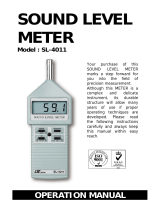
CEL-63x Environmental & Occupational Noise Meter
3 Casella CEL
System Tools ................................................................................................................... 28
Status .............................................................................................................................. 29
Measurement stop screen ............................................................................................... 29
Calibration mode ............................................................................................................. 32
Measurement run screens ............................................................................................... 34
Menu screens .................................................................................................................. 36
USB connect mode .......................................................................................................... 50
4.4 Measurement views ........................................................................................................ 51
User settings.................................................................................................................... 51
Measurement functions ................................................................................................... 53
4.5 Community Noise Measurements (L
dn
, L
den
and CNEL) ................................................. 57
4.6 Connections .................................................................................................................... 60
Power input port ............................................................................................................. 60
Mini B USB port .............................................................................................................. 60
AC and DC output port ................................................................................................... 61
5 Mode Selection (SLM, Online, NNR) ............................................................................... 62
5.1 General ............................................................................................................................ 62
5.2 SLM Mode ....................................................................................................................... 62
5.3 Online Mode ................................................................................................................... 62
5.4 NNR Mode ....................................................................................................................... 63
6 Specifications................................................................................................................... 64
6.1 General ............................................................................................................................ 64
6.2 Standards ........................................................................................................................ 65
6.3 Measurement range ........................................................................................................ 65
6.4 RMS frequency weightings ............................................................................................. 65
6.5 Octave and 1/3-Octave measurement ............................................................................. 66
6.6 Peak measurement ......................................................................................................... 66
6.7 RMS detector .................................................................................................................. 66
6.8 Noise floor ...................................................................................................................... 66
6.9 Frequency response ........................................................................................................ 66
6.10 Time weightings .............................................................................................................. 66
6.11 Correction filters ............................................................................................................. 67
6.12 Reference direction ......................................................................................................... 67
6.13 Reference conditions ...................................................................................................... 67
























